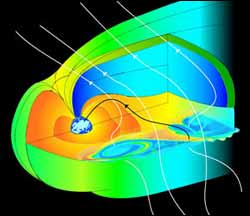This area deals with the fundamental laws and building blocks of nature and how they interact, the properties and the behavior of matter, and research into space and time and their structures.
innovations-report provides in-depth reports and articles on subjects such as astrophysics, laser technologies, nuclear, quantum, particle and solid-state physics, nanotechnologies, planetary research and findings (Mars, Venus) and developments related to the Hubble Telescope.

A bevy of satellites buzzing around in the Earth’s magnetosphere has found at least part of the answer to a long-standing puzzle about the source of the charged particles that feed the aurora.
The charged particles come from explosions on the sun and smash into the Earth’s magnetic field, which repels the bulk of them. But many slip through, often via a physical process called magnetic reconnection, where the magnetic field traveling with the particles breaks and reconnect

A new method for looking at the composition of comets using ground-based telescopes has been developed by chemists at UC Davis. Remnants from the formation of our solar system, the makeup of comets gives clues about how the Earth and other planets formed.
William Jackson, professor and chair of chemistry at UC Davis; researchers Alexandra Scodinu and Dadong Xu; and Anita Cochran of the University of Texas at Austin have developed methods to use visible and ultraviolet spectroscopy

ESA’s Mars Express has relayed pictures from one of NASA’s Mars rovers for the first time, as part of a set of interplanetary networking demonstrations. The demonstrations pave the way for future Mars missions to draw on joint interplanetary networking capabilities. ESA and NASA planned these demonstrations as part of continuing efforts to cooperate in space exploration.
On 4 August at 14:24 CEST, as Mars Express flew over one of NASA’s Mars exploration rovers, Opportunity, i

The eyes aboard the Mars rover Spirit are delivering ground truth.
After more than six months of examining the photographic and spectral data from the rover, Mars mission scientists confirm that the albedo — which is the percentage of sunlight reflected on the red planet’s dusty surface — indicates important variations in mineral and dust composition.
“Spirit landed in a medium brightness region of Gusev crater, and on this mission has crossed into brighter and dark

Whether viewed dimly through the haze and lights of a city or in all their glory in a pristine wilderness, the stars that surround the Earth are magnificent, and one day Earthlings will travel to some of the new planets that astronomers are locating. However, the stars we see are not necessarily where we think they are, according to an international research team.
“We know that the light from distant stars takes a very long time to reach the Earth,” says Dr. Akhlesh Lakhtakia, distin

MIT research on the most exciting questions in astrophysics and space science has been recognized by a $7.5 million gift from the Kavli Foundation that will jumpstart new studies of the cosmos.
“The Kavli gift allows us to invest in new scientific areas and new technologies at the forefront of these fields,” said Professor of Physics Jacqueline N. Hewitt. “We can bring new tools to bear on some of the most interesting questions before us: What is the dark energy that appears to